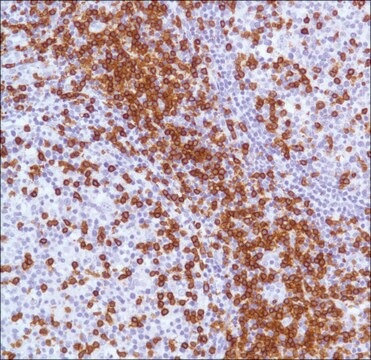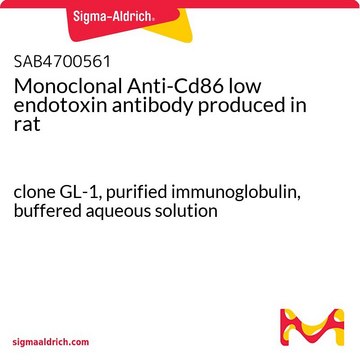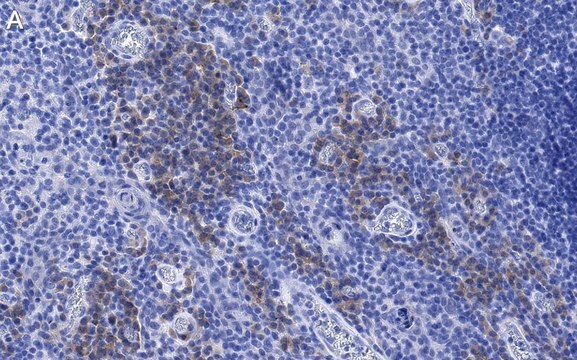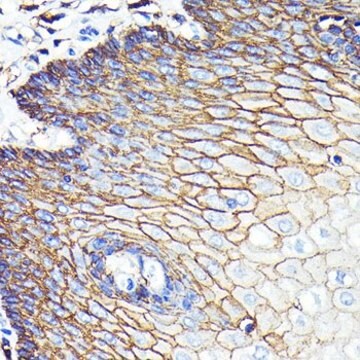SAB4700560
Monoclonal Anti-Cd86 antibody produced in rat
clone GL-1, purified immunoglobulin, buffered aqueous solution
Sign Into View Organizational & Contract Pricing
All Photos(1)
About This Item
UNSPSC Code:
12352203
NACRES:
NA.41
conjugate:
unconjugated
application:
FACS
clone:
GL-1, monoclonal
species reactivity:
mouse
citations:
1
technique(s):
flow cytometry: suitable
Recommended Products
biological source
rat
Quality Level
conjugate
unconjugated
antibody form
purified immunoglobulin
antibody product type
primary antibodies
clone
GL-1, monoclonal
form
buffered aqueous solution
species reactivity
mouse
concentration
1 mg/mL
technique(s)
flow cytometry: suitable
isotype
IgG2a
NCBI accession no.
UniProt accession no.
shipped in
wet ice
storage temp.
2-8°C
target post-translational modification
unmodified
Gene Information
mouse ... Cd86(12524)
General description
The rat monoclonal antibody GL-1 reacts with CD86 (B7-2), a 70-80 kDa type I transmembrane glycoprotein of immunoglobulin supergene family, expressed on professional antigen-presenting cells, such as dendritic cells, macrophages or activated B lymphocytes.
Immunogen
LPS-activated CBA/Cs mouse splenic B cells
Application
The reagent is designed for Flow Cytometry analysis. Suggested working dilution is 2 μg/mL of sample. Indicated dilution is recommended starting point for use of this product. Working concentrations should be determined by the investigator.
Features and Benefits
Evaluate our antibodies with complete peace of mind. If the antibody does not perform in your application, we will issue a full credit or replacement antibody. Learn more.
Physical form
Solution in phosphate buffered saline, pH 7.4, with 15 mM sodium azide.
Disclaimer
Unless otherwise stated in our catalog or other company documentation accompanying the product(s), our products are intended for research use only and are not to be used for any other purpose, which includes but is not limited to, unauthorized commercial uses, in vitro diagnostic uses, ex vivo or in vivo therapeutic uses or any type of consumption or application to humans or animals.
Not finding the right product?
Try our Product Selector Tool.
Storage Class Code
10 - Combustible liquids
Flash Point(F)
Not applicable
Flash Point(C)
Not applicable
Choose from one of the most recent versions:
Certificates of Analysis (COA)
Lot/Batch Number
Don't see the Right Version?
If you require a particular version, you can look up a specific certificate by the Lot or Batch number.
Already Own This Product?
Find documentation for the products that you have recently purchased in the Document Library.
Xiaoli Wang et al.
Proceedings of the National Academy of Sciences of the United States of America, 116(42), 21113-21119 (2019-10-03)
Costimulation is required for optimal T cell activation, yet it is unclear whether poxviruses dedicatedly subvert costimulation during infection. Here, we report that the secreted M2 protein encoded by cowpox virus (CPXV) specifically interacts with human and murine B7.1 (CD80)
Christiane S Heilingloh et al.
The Journal of general virology, 95(Pt 6), 1366-1375 (2014-03-20)
Mature dendritic cells (mDCs) are the most potent antigen-presenting cells known today, as they are the only antigen-presenting cells able to induce naïve T-cells. Therefore, they play a crucial role during the induction of effective antiviral immune responses. Interestingly, the
Laura J Vella et al.
Cancer immunology research, 2(4), 351-360 (2014-04-26)
Combination therapy with BRAF and MEK inhibition is currently in clinical development for the treatment of BRAF-mutated malignant melanoma. BRAF inhibitors are associated with enhanced antigen-specific T-lymphocyte recognition in vivo. Consequently, BRAF inhibition has been proposed as proimmunogenic and there
Jingjuan Meng et al.
International journal of biological macromolecules, 69, 388-392 (2014-06-20)
The seaweed Laminaria japonica has been investigated in a laboratory research for its medical significance and LJP has been purified now. The objective of present study was to look at effect of LJP on structural, phenotypic and functional maturation of
Adrienne Müller et al.
International journal of cardiology, 174(3), 503-515 (2014-05-20)
Myocardial infarction and stroke are the life-threatening consequences after plaque rupture in coronary or carotid arteries. Positron emission tomography employing [(18)F]fluorodeoxyglucose can visualize plaque inflammation; however, the question remains whether this is specific for plaque vulnerability. The pathophysiology of vulnerable
Our team of scientists has experience in all areas of research including Life Science, Material Science, Chemical Synthesis, Chromatography, Analytical and many others.
Contact Technical Service






